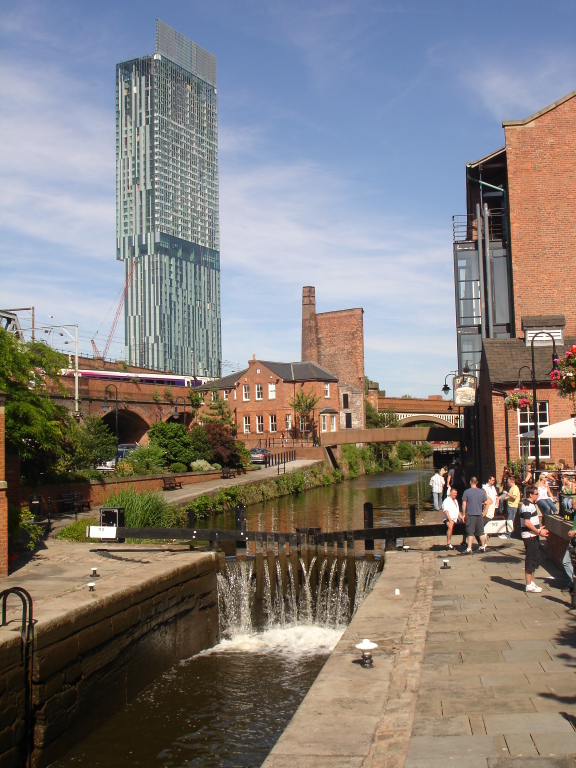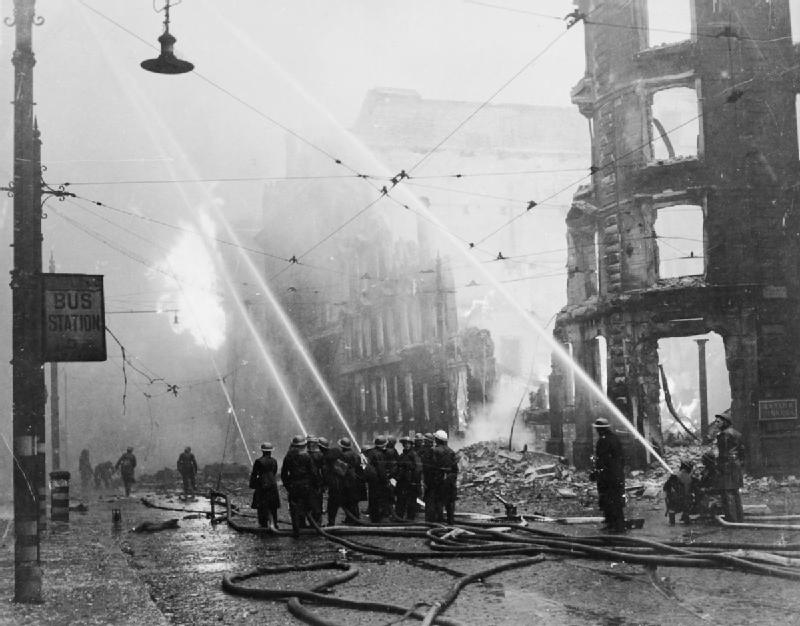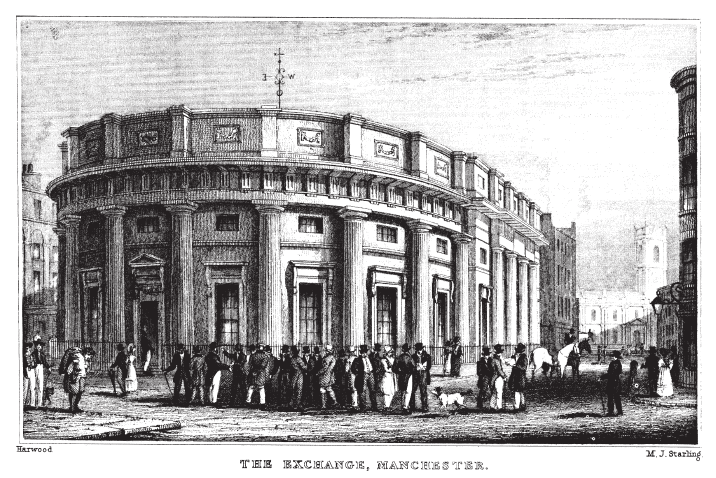|
Manchester City Centre
Manchester City Centre is the central business district of Manchester in Greater Manchester, England situated within the confines of Great Ancoats Street, A6042 Trinity Way, and A57(M) Mancunian Way which collectively form an inner ring road. The City Centre ward had a population of 17,861 at the 2011 census. Manchester city centre evolved from the civilian '' vicus'' of the Roman fort of Mamucium, on a sandstone bluff near the confluence of the rivers Medlock and Irwell. This became the township of Manchester during the Middle Ages, and was the site of the Peterloo Massacre of 1819. Manchester was granted city status in 1853, after the Industrial Revolution, from which the city centre emerged as the global centre of the cotton trade which encouraged its "splendidly imposing commercial architecture" during the Victorian era, such as the Royal Exchange, the Corn Exchange, the Free Trade Hall, and the Great Northern Warehouse. After the decline of the cotton trade an ... [...More Info...] [...Related Items...] OR: [Wikipedia] [Google] [Baidu] |
Central Business District
A central business district (CBD) is the commercial and business centre of a city. It contains commercial space and offices, and in larger cities will often be described as a financial district. Geographically, it often coincides with the " city centre" or " downtown". However, these concepts are not necessarily synonymous: many cities have a central ''business'' district located away from its commercial and or cultural centre and or downtown/city centre, and there may be multiple CBDs within a single urban area. The CBD will often be characterised by a high degree of accessibility as well as a large variety and concentration of specialised goods and services compared to other parts of the city. For instance, Midtown Manhattan, New York City, is the largest central business district in the city and in the United States. London's city centre is usually regarded as encompassing the historic City of London and the medieval City of Westminster, while the City of London and the trans ... [...More Info...] [...Related Items...] OR: [Wikipedia] [Google] [Baidu] |
Middle Ages
In the history of Europe, the Middle Ages or medieval period lasted approximately from the late 5th to the late 15th centuries, similar to the post-classical period of global history. It began with the fall of the Western Roman Empire and transitioned into the Renaissance and the Age of Discovery. The Middle Ages is the middle period of the three traditional divisions of Western history: classical antiquity, the medieval period, and the modern period. The medieval period is itself subdivided into the Early Early may refer to: History * The beginning or oldest part of a defined historical period, as opposed to middle or late periods, e.g.: ** Early Christianity ** Early modern Europe Places in the United States * Early, Iowa * Early, Texas * Early ..., High Middle Ages, High, and Late Middle Ages. Population decline, counterurbanisation, the collapse of centralized authority, invasions, and mass migrations of tribes, which had begun in late antiquity, continued i ... [...More Info...] [...Related Items...] OR: [Wikipedia] [Google] [Baidu] |
Township Of Manchester
A township is a kind of human settlement or administrative subdivision, with its meaning varying in different countries. Although the term is occasionally associated with an urban area, that tends to be an exception to the rule. In Australia, Canada, Scotland and parts of the United States, the term refers to settlements too small or scattered to be considered urban. Australia The Australian National Dictionary, ''The Australian National Dictionary'' defines ''township'' as: "A site reserved for and laid out as a town; such a site at an early stage of its occupation and development; a small town". The term refers purely to the settlement; it does not refer to a unit of government. Townships are governed as part of a larger council (such as that of a shire, district or city) or authority. Canada In Canada, two kinds of township occur in common use. *In Eastern Canada, a township is one form of the subdivision of a county. In Canadian French, this is a . Townships are refer ... [...More Info...] [...Related Items...] OR: [Wikipedia] [Google] [Baidu] |
1996 Manchester Bombing
The 1996 Manchester bombing was an attack carried out by the Provisional Irish Republican Army (IRA) on Saturday, 15 June 1996. The IRA detonated a lorry bomb on Corporation Street, Manchester, Corporation Street in the Manchester city centre, centre of Manchester, England. It was the biggest bomb detonated in Great Britain since the World War II, Second World War. It targeted the city's infrastructure and economy and caused significant damage, estimated by insurers at £700 million (equivalent to £ in ), a sum surpassed only by the 1993 Bishopsgate bombing, also by the IRA. At the time, England was hosting the UEFA Euro 1996, Euro '96 association football, football championships and a Russia national football team, Russia vs. Germany national football team, Germany match was scheduled to take place in Manchester the following day. The IRA sent telephoned warnings about 90 minutes before the bomb detonated. At least 75,000 people were evacuated, but the Bomb disposal, ... [...More Info...] [...Related Items...] OR: [Wikipedia] [Google] [Baidu] |
BBC News
BBC News is an operational business division of the British Broadcasting Corporation (BBC) responsible for the gathering and broadcasting of news and current affairs in the UK and around the world. The department is the world's largest broadcast news organisation and generates about 120 hours of radio and television output each day, as well as online news coverage. The service maintains 50 foreign news bureaus with more than 250 correspondents around the world. Deborah Turness has been the CEO of news and current affairs since September 2022. In 2019, it was reported in an Ofcom report that the BBC spent £136m on news during the period April 2018 to March 2019. BBC News' domestic, global and online news divisions are housed within the largest live newsroom in Europe, in Broadcasting House in central London. Parliamentary coverage is produced and broadcast from studios in London. Through BBC English Regions, the BBC also has regional centres across England and national new ... [...More Info...] [...Related Items...] OR: [Wikipedia] [Google] [Baidu] |
CIS Tower
The CIS Tower is an office skyscraper on Miller Street in Manchester, England. Designed for the Co-operative Insurance Society (CIS) by architects Gordon Tait and G. S. Hay, the building was completed in 1962 and rises to 118 m (387 feet) in height. As of 2022, the Grade II listed building is Manchester's 10th-tallest building and the second-tallest office building in the United Kingdom outside London after City Tower. The tower remained as built for over 40 years, until maintenance issues on the service tower required an extensive renovation, which included covering its façade in photovoltaic panels. Location The tower is situated on Miller Street, which forms the Manchester Inner Ring Road, and stands adjacent to New Century House, a high-rise office building also designed by Gordon Tait and G. S. Hay and constructed concurrently for the CIS's parent company, the Co-operative Wholesale Society (CWS). The plot on which the building stands had been heavily bombed during ... [...More Info...] [...Related Items...] OR: [Wikipedia] [Google] [Baidu] |
Manchester Blitz
The Manchester Blitz (also known as the Christmas Blitz) was the heavy bombing of the city of Manchester and its surrounding areas in North West England during the Second World War by the German ''Luftwaffe''. It was one of three major raids on Manchester, an important inland port and industrial city; Trafford Park in neighbouring Stretford was a major centre of war production. Raids on Manchester Air raids began in August 1940, and in September 1940 the Palace Theatre on Oxford Street was hit. The heaviest raids occurred on the nights of 22/23 and 23/24 December 1940, killing an estimated 684 people and injuring more than 2,000. Manchester Cathedral, the Royal Exchange, the Free Trade Hall and the Manchester Assize Courts were among the large buildings damaged. On the night of 22/23 December 272 tons of high explosive were dropped, and another 195 tons the following night. Almost 2,000 incendiaries were also dropped on the city over the two nights. The aircraft spr ... [...More Info...] [...Related Items...] OR: [Wikipedia] [Google] [Baidu] |
Great Northern Warehouse
The Great Northern Warehouse is the former railway goods warehouse of the Great Northern Railway in Manchester city centre, England, which was refurbished into a leisure complex in 1999. The building is at the junction of Deansgate and Peter Street. It was granted Grade II* listed building status in 1974. The warehouse was built to be fireproof with a steel frame on a rectangular plan, 267 feet long by 217 feet wide and five storeys high, with 27 windows on the east and west sides and 17 windows on the north and south ends. All four sides have friezes lettered in white brick reading "Great Northern Railway Company's Goods Warehouse". It was built above the Manchester and Salford Junction Canal, and a dock beneath was constructed to allow goods to be transferred to and from canal barges via shafts and a complex system of haulage using hydraulic power. The building could hold a total of 150 goods wagons across two of its levels, with capacity for a further 500 in its sidings. I ... [...More Info...] [...Related Items...] OR: [Wikipedia] [Google] [Baidu] |
Free Trade Hall
The Free Trade Hall on Peter Street, Manchester, England, was constructed in 1853–56 on St Peter's Fields, the site of the Peterloo Massacre. It is now a Radisson hotel. The hall was built to commemorate the repeal of the Corn Laws in 1846. The architect was Edward Walters. It was owned by the Manchester Corporation and was bombed in the Manchester Blitz; its interior was rebuilt and it was Manchester's premier concert venue until the construction of the Bridgewater Hall in 1996. The hall was designated a Grade II* listed building in 1963. History The Free Trade Hall was built as a public hall between 1853 and 1856 by Edward Walters on land given by Richard Cobden in St Peter's Fields, the site of the Peterloo Massacre. Two earlier halls had been constructed on the site, the first, a large timber pavilion was built in 1840, and its brick replacement built in 1842. The halls were "vital to Manchester's considerable role in the long campaign for the repeal of the Corn Laws. ... [...More Info...] [...Related Items...] OR: [Wikipedia] [Google] [Baidu] |
Corn Exchange, Manchester
Corn Exchange, Manchester is a grade II listed building in Manchester, England. The building was originally used as a corn exchange and was previously named the Corn & Produce Exchange, and subsequently The Triangle. Following the IRA bomb in 1996 it was renovated and was a modern shopping centre till 2014. The building was sold to investors and has been re-developed into a dining destination with food outlets. History The first Corn Exchange built on this site in 1837 was designed by Richard Lane. This was demolished in 1896 and replaced in two sections between 1896 and 1903. Each section was designed by a different architect, the first from 1896–99 by Ball & Elce and the second, from 1899–1903, by Potts, Son, & Hennings. Before 1837 it traded from Hanging Ditch. The Corn & Produce Exchange was the gathering spot for thousands of traders from all over the region. This continued until the economic depression of the 1920s and 1930s. Following the Second World War, trade ... [...More Info...] [...Related Items...] OR: [Wikipedia] [Google] [Baidu] |
Royal Exchange, Manchester
The Royal Exchange is a grade II listed building in Manchester, England. It is located in the city centre on the land bounded by St Ann's Square, Exchange Street, Market Street, Cross Street and Old Bank Street. The complex includes the Royal Exchange Theatre and the Royal Exchange Shopping Centre. The Royal Exchange was heavily damaged in the Manchester Blitz and in the 1996 Manchester bombing. The current building is the last of several buildings on the site used for commodities exchange, primarily but not exclusively of cotton and textiles. History, 1729 to 1973 The cotton industry in Lancashire was served by the cotton importers and brokers based in Liverpool who supplied Manchester and surrounding towns with the raw material needed to spin yarns and produce finished textiles. The Liverpool Cotton Exchange traded in imported raw cotton. In the 18th century, the trade was part of the slave trade in which African slaves were transported to America where the cotton was g ... [...More Info...] [...Related Items...] OR: [Wikipedia] [Google] [Baidu] |
Victorian Era
In the history of the United Kingdom and the British Empire, the Victorian era was the period of Queen Victoria's reign, from 20 June 1837 until her death on 22 January 1901. The era followed the Georgian period and preceded the Edwardian period, and its later half overlaps with the first part of the ''Belle Époque'' era of Continental Europe. There was a strong religious drive for higher moral standards led by the nonconformist churches, such as the Methodists and the evangelical wing of the established Church of England. Ideologically, the Victorian era witnessed resistance to the rationalism that defined the Georgian period, and an increasing turn towards romanticism and even mysticism in religion, social values, and arts. This era saw a staggering amount of technological innovations that proved key to Britain's power and prosperity. Doctors started moving away from tradition and mysticism towards a science-based approach; medicine advanced thanks to the adopti ... [...More Info...] [...Related Items...] OR: [Wikipedia] [Google] [Baidu] |

.jpg)

.jpg)




.jpg)

